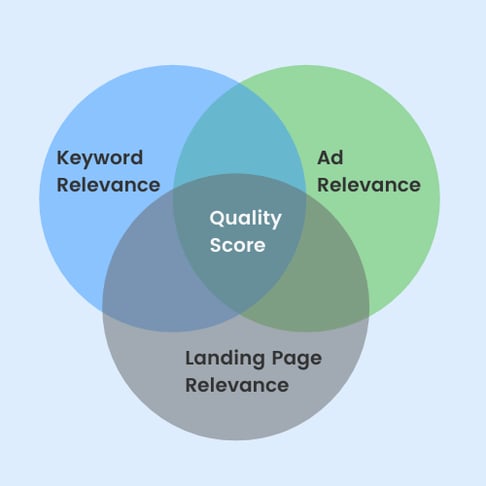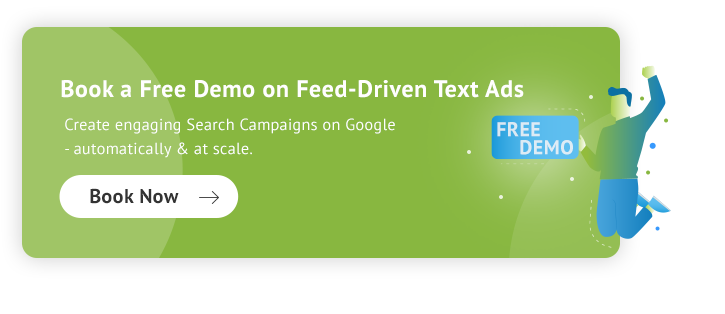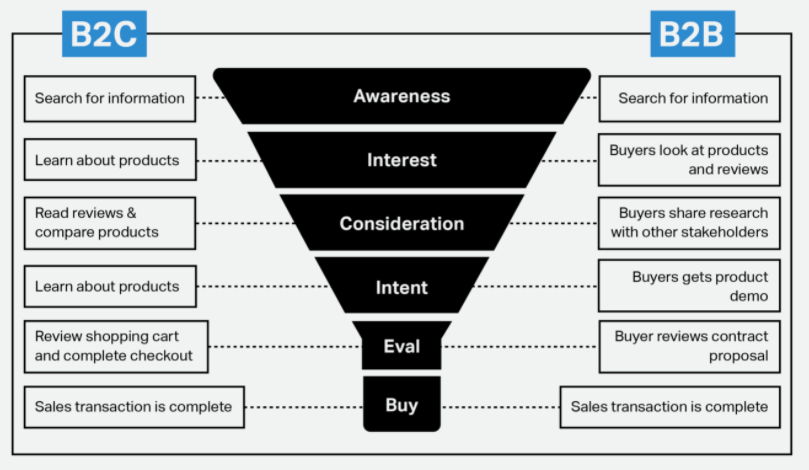According to research from Datareportal, 81% of customers search online for a product or service to purchase. This fact only confirms that SEM (Search engine marketing) is a crucial step in your lead generation strategy. Another study from Pardot highlights that 72% of customers begin their purchase journey at a search engine, and therefore a successful SEO and PPC strategy is crucial.
With pay-per-click advertising, your business can make your broader marketing and sales strategies smarter. Results will always depend on how you utilize your PPC.
Maybe you:
- Have a unique product that few know exists
- Want to protect your brand to ward off competitors
- Want to generate awareness and interest within your marketplace
Whatever your goals may be, follow these 6 PPC tips for B2Bs to create the best strategy for generating leads for your business.
SEM for B2B and B2C: Differences
It is often found that across various industries the search volume for B2B keywords is lower than typically found in B2C advertising. This tends to happen because they can be very industry-specific terms. Additionally in some marketplaces, the same keyword can be meant for both B2C and B2B. In these instances, the messaging has to be extra clear- tailored specifically for who the ad is meant.Here, both B2C and B2B keywords can get very specific. Some companies only work with enterprise-level companies, whereas others work with very small businesses. In this case, they may both risk bidding on the same keyword, but ultimately want to acquire completely different audiences.
Usually, in B2C, advertisers immediately aim to generate sales on a specific landing page. In B2B this isn’t so.
Usually, B2B advertisers try to get a user's contact information by:
- Downloading a case study
- Downloading an eBook
- Opting for a free trial
- Requesting a demo.
In this way, the user becomes a part of the nurture flow and becomes integrated with the sales funnel.
Once a company has this customer’s information, they will likely send multiple email drip campaigns to re-engage the user. This helps push them towards the final decision and purchase.
Another crucial aspect to understand is that while generating SEM leads, not all of the leads will necessarily be of high quality. In order to navigate through this, companies often use their own lead grading systems or software. This helps their sales teams assess which leads to prioritizing for contacting first.
Ultimately, the reason for using SEM in B2B is the same as for B2C- to both generate brand awareness and conversions (whether these be sales or leads).
Due to this, search engine marketing remains to be the best channel for capturing people right when they have high intent.
This ensures you are able to protect your brand. Bidding on both your own company name terms and top products and services prevents competitors from stealing your traffic.
1. Adjust Keywords to Your Target Audience
When setting up a B2B strategy, it is crucial to consider who will be actively searching for your solution- is it a marketing manager, a CEO, a managing director?
All ads need to be adjusted for each individual case. Notably, the lower the level of the individual searching, the harder it will potentially be for you to reach the decision-maker.
That’s because you will need to rely on the management team to upsell the idea or product up the chain. A tip would be to remember to use the abbreviation related to your industry, as some departments may be using those instead of full words.
For example, a PPC professional would rarely search "pay per click solution;" instead they would use "PPC solution".
Research
Research is vital when creating a PPC campaign for B2B, and it requires having a thorough understanding of your target client.
Without proper understanding, you could be wasting money on terms vaguely related to the industry, but not the specific offer your company has. Also, if you advertise globally, it’s important to consider any region-specific solutions.
As an example, a particular B2B SaaS company offers web accessibility solutions as one of their products and has the term ‘AODA’ which is very industry-specific. This term is ONLY applicable in Canada, so the budget could be wasted advertising this in the USA.
Keywords: Find high-value keywords for your B2B PPC campaign
For conducting keyword research, there are a variety of ways to begin building out your account structure. We recommend:
1. Finding keywords via Google Keyword Planner, Google Analytics, or Search Console.
Companies can use Google Keyword Planner, or check their Search Console in Google Analytics to see which searches specifically drive traffic.
2. Internal SEO department.
If you have an internal SEO department within your business, ask to share their top keywords.
3. Utilizing keyword research software.
You can use platforms like:
- Ahrefs, KeywordsFX,
- Answer the Public,
- FAQ Fox,
- Google Trends,
- and SEM Rush for finding keywords.
4. Using Dynamic Search Ads.
If ever in doubt, it's also possible to use Dynamic Search Ads (DSAs). They crawl your site (you can also select specific pages to target) and run ads based on the content of your site.
5. Competitor research.
It's possible to determine the keywords your competitors are targeting. Google provides a competitor and search impression share report within Google Ads which is invaluable. It's also possible to manually search on Google to determine which areas your competitors are covering.
However, first and foremost, you should always start by using industry experience and common sense in order to implement keywords that have high intent. This way, feedback can be generated fairly quickly.
How to implement your keywords
We'd recommend adding keywords into campaigns and ad groups in phrase or broad match, in order to capture additional traffic.
Start with a wider net of broader match keywords, and then use data collected to refine down lists, adding in more exact match terms.
One notable point to mention is that the only difference between B2B and B2C keywords match type targeting is that in B2B advertising, synonyms and acronyms are often used in the industry.
It's important to think from the perspective of the customer, and which specific abbreviations they may be using.
B2B marketers often have specific part or item numbers, which can be organized and arranged into a highly structured PPC campaign. Collecting insights from the sales team here can also be beneficial, and top-selling products may be worth promoting as a priority.
Furthermore, it may be worthwhile applying the product or service you’re selling to the specific niche and market area it may be sold to.
For example, add an industry such as ‘construction’ or ‘agriculture’’ to find valuable long-tail terms such as “GPR for construction” or “farming hydraulic tie-rods.”
Bidding
Bidding varies greatly from industry to industry. However, when promoting high-value items and services, companies typically have larger profit margins. Therefore it can be less of an issue to increase PPC ad spend should this be recommended.
Finally, some typical B2B industry keyword variations include adding the following to the original product sold:
- Wholesale
- Supplier
- Trade
- Vendor
- Company
- Supplier
- Tools
On the contrary, negative keywords often revolve around:
- Free
- Offer
- Discount
- Job
- Reviews
Audience targeting
Keywords combined with Google’s predefined audiences are a great way to boost your search campaigns. Google offers a range of audiences that provide powerful insights into who is bidding on your ads, and the best part is that they’re easy to test at first with no additional cost.
Simply add your audiences in observation mode, and see the results. Then, when enough data has been collected, you can start to apply bid adjustments to your most successful audiences.
2. Improve Your B2B PPC Ad Campaign Structure
Generally speaking, in PPC there is no difference whether you are in B2C or B2B regarding structuring your account. The best practices apply for both. That being said, it is never the case that ‘one campaign structure fits all'.
At the same time, there isn't one campaign structure that is best. Each PPC manager tends to prefer their own account structure, and this may vary from sector to sector or client to client.
|
Extra Tips: Naming campaigns One of the most important things to keep in mind is the naming method throughout your account. Keep the naming of your campaigns the same. This logic makes for easy reading and understanding of your results and helps to create a concise and consistent account structure. This prevents any unnecessary messiness and ensures it’s easy to understand what the campaign is targeting. Some companies split campaigns:
|
You need to see what makes sense for you. Additionally, it’s worth noting that sometimes it may be easier to split out campaigns gradually and briefly to start. Beginning with a simple account structure can then be expanded and grown as more data is collected and results are driven.
Build a campaign for a specific buyer
A smart business wants to become a big fish in a small pond, rather than a small fish in a big pond. If it's an agency that's launching a PPC campaign for a client that has a particular audience in mind, then the ads ought to be created for a highly specific group of people; those who are most likely to be attracted by the client's product or service.
It’s crucial to try to think like potential buyers and those who are involved in making decisions about every purchase. Think about whether they already have good knowledge of the service/product, or if they don´t know about it yet. Once you define the final audience you should adjust the proper campaign to them.
Ad Groups: Organize your ad group for success!
For many years, the best way to structure an ad group was the so-called ‘SKAG’ approach or ‘single keyword ad group.’ This means you have only one keyword per ad group, preferably in an exact match. The reasoning was that you could make hyper-relevant ad copy, and thereby generate strong quality score within the account.
Google has since loosened up its match-type formats. It no longer makes sense to use only this structure. Now a better approach is to have more keywords in various match types.
Our top recommendation, especially for B2B, is to try and group the keywords by relevance in order to have more data per ad group.

It is possible to arrange ad groups by your company’s steps in the buying funnel. In the case of B2B PPC advertising, it is often suitable to target those users at the top or middle of the funnel with ads. These are the future leads that ought to be valued and nourished.
For these users in particular, it is important to highlight the overall benefits of purchasing products and services like yours, rather than personalizing ad copy with the benefits of your specific product.
3. Incentivize your ad copy
As mentioned before, PPC B2B and B2C marketers can bid on the same keyword while simultaneously wanting to attract a completely different audience. Within B2B companies themselves, there may be different target audiences based on size. One company might be looking to attract enterprise-level businesses while another company wants to attract SMBs.
They both bid on the same keywords but have entirely different aims. That's why it's important to create ads with your audience in mind. This can be as simple as putting "solution for enterprises" in the ad.
Alternatively, if you want to target SMBs, ensure this is included in the ad. That way you are less likely to get unqualified clicks, saving you some money.
|
Extra Tip: It’s much easier to create better ad copy with a third-party tool like DataFeedWatch. DataFeedWatch enables you to:
|
Next Recommended Read: How to Improve Your Ad Copy to Increase Sales: Best Practices
4. Get your tracking right
The most important thing in PPC is tracking data. Without it, you will naturally be running your Google ads based on assumptions.
So before you launch anything, make sure your tracking is correctly set up. Try to track as much as possible in ways like:
- Requesting a demo
- PDF downloads
- Free trials
- Quizzes
Visualizing this data through PPC Charts can help you identify trends, measure performance, and optimize campaign results effectively.
This ultimately links to knowing the absolute purpose of your campaign, and wider than this, your overall business goals.
This is why practical settings are extremely important, as they concretely link to the results of the campaign, and how we are able to measure its progress, gaining information about leads.
Track anything you think is valuable. Some conversions are more beneficial than others. For example, downloading a report is not as ‘hot’ as ‘request a demo,’ but is often essential in warming up the potential customer.
How to use Remarketing Campaigns for B2B Businesses
Remarketing campaigns are extremely important in B2B PPC, and help to push users through the buying funnel. When you consider that 98% of overall website visitors leave without converting, remarketing opens the door to re-engage with them across the web.
This can lead to an 85% increase in conversions. Perks of remarketing include sustaining brand awareness, nurturing leads, and recapturing lost leads.
For example, if you generate contact information from any lead who completes an online quiz, you can make a list of those users. Then you can remarket them on different platforms, giving them more information about your company.
You can also make a list of these users and then retarget with the next ‘step’ in the funnel, perhaps a case study. Make a list of users who downloaded a case study and remarket to those with stronger call to action like ‘request a demo.’
So with remarketing, you can push the cold leads through the funnel so they can become hot leads. This also applies to B2C, but is especially important in B2B because here we have to warm up the leads much more and for much longer.
Ultimately, this is why correct conversion tracking is essential.
It's crucial to not to make any large decisions and changes in your account without backing the reasoning up with data. This is especially true for remarketing campaigns, which in general tend to feature small audiences.
5. Use different Types of Ads
Dynamic Search Ads
Dynamic Search Ads is a great ad type to capture additional traffic and use these search terms in your normal campaigns. DSA has no keywords. Instead, Google crawls your site and determines for itself which searches to show your ad for.
It is very dynamic. All you provide is description lines and then the headlines are generated by Google. An additional bonus is that sometimes Google exceeds the character limit when it is a DSA ad. You can target specific pages in order to optimize the description lines so that they are relevant to the content of the page. You can also exclude pages like "about us" if you think that is not relevant.
Aside from DSA, Google's default ad type currently is Responsive Search Ads, so you need at least one of these ad types to be able to run ads.
Video Ads
It's quite common to use video ads, specifically YouTube ads. These are mainly used for brand awareness, as opposed to conversion performance. Many B2B PPC marketers create different video strategies, similar to the above-mentioned remarketing strategies.
The logic is the same:
- Create a broad video ad
- Create a list of people who have seen the video
- Remarket to this audience with another video that explains the product/service more in-depth
As mentioned, you may not see great performance from a conversion perspective, but it definitely is an additional touchpoint in the user journey. We recommend creating a list of users who have seen a YouTube ad and adding it as an observation to all of your search campaigns.
Then after some time, you can do an audience analysis and see if people who have seen your YouTube ad are doing a search for your brand or the solution/product you offer.
YouTube video ads bring your brand’s story to life via video. You are able to reach potential customers as they browse on YouTube or watch videos directly, and only pay when they show some form of interest.
Google enables us to set up video ads in three simple steps:
- Choose your ad type
- Select an audience
- Set your budget
6. Quick Expert Tips
A cross-channel approach
A big tip for B2B PPC managers is not to assess their channels in isolation; check what is happening across channels, and how your ads support the rest of the strategy.
Don't just look at your leads and be happy. Look at what happens with these leads. Do they get picked up by sales? Do they actually become customers? The mistake here usually is that PPC managers see cost per lead being low for some keywords/product campaigns and then decide to allocate more spend without suspecting that these leads never become customers.
The risk is that they have other keywords/campaigns with a much stronger quality of lead, but they see the CPA being much higher than in another campaign and decide to cut the spend. It’s crucial to look at the whole process beyond the Google Ads platform in order to get a feel for what is occurring in the whole business.
Attribution
This is a heavily discussed matter within B2B industries, mainly due to longer sales cycles. It may never be 100% solved, but what is important in the B2B context is to understand it. If you're looking to learn more on the topic of attribution, here's a useful guide.
Conclusion
Yes, PPC for B2B absolutely works, but you can't just judge the performance of a single channel. Instead, you have to have a holistic overview and understand how PPC supplements your overall marketing strategy.
The hardest part in B2B is attribution, which is why teams within organizations create their own attribution models or use software to help with that. The sales cycles are very long, so PPC usually is used for lead generation; a simple action the user has to make in order to capture their contact information.
As always, there is no ‘one fits all approach in PPC, for either B2C or B2B. It is unique to the industry, company, and your target audience.
In order to find the best approach, it is essential to do multiple experiments, tests, and to challenge your current setup in order to get ahead of your competition.
If you're looking for more PPC out-of-the-box tactics, visit the article:


